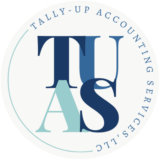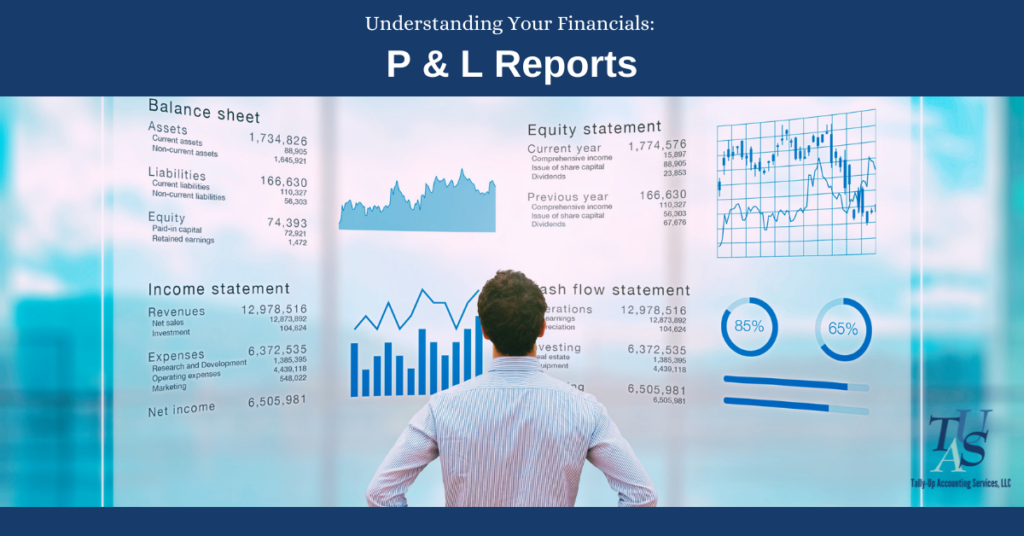Last month we reviewed the benefits of the Balance Sheet and this month we are reviewing what is likely the most important of all your financial reports: Profit & Loss (P&L) report.
A Profit & Loss Report is also known as an “Income Statement,” a “Statement of Operations,” a “Statement of Financial Results” and “Income & Expense Statement.” We like using “Profit & Loss Report” as that is what the report shows: your profit or loss for a given period of time.
The report provides the information via a simple equation:
Total Income – Total Expenses = Profit/Loss
Why is a P&L Report Important?
This report is valuable, maybe even the most important financial statement, as it shows how your business is doing and it is useful in identifying areas that need to be addressed.
The P&L statement gives you crucial information about how much revenue to bring in to cover expenses. This report can help identify where to cut out expenses, areas to increase revenue, and whether your business is profitable or not. When used over a period of time, the P&L Report can identify income and revenue trends and show the real strength and earning power of a company over a period.
As a business owner, this information is critical in creating a strong financial and business plan. One client neglected reviewing their P &L statement for over six months and did not identify serious issues that eventually led the company to face bankruptcy. Had the business owner stayed on top of reviewing this information, they may have had time to build a plan to keep the company open.
If you are a business of one or a solopreneur structured as an LLC, you may be required to provided P&L reports for personal loan or grant applications. You will likely need to provide P&L information if you plan on restructuring as an S-CORP in the future.
Bottomline is that you need to be able to assess your revenue in relation to your expenses.
Understanding and Building a Solid P& L Report
As with any financial report, without accurate information, you cannot run your business effectively. Here is a synopsis of what is included in each area:
- Total Income includes all your income sources, which for most companies is primarily sales.
- Total Expenses include any cost associated with running the day-to-day operations of the business, such as staff wages, rent, utilities, cost of goods sold, etc.
Now that you have your Total Income and Total Expenses, let’s look at your Profit Margin, which is your profitability ratio.
(Net Income/Total Income) x 100% = Profit Margin
Let’s add some figures in to see how the numbers work.
Example: The ECO Company had a total income last month of $10,000 and $8,500 in expenses. Their Profit & Loss report would show the following information:
Total Income – Total Expenses = Profit/Loss (Net Income)
$10,000 – $8,500 = $1,500
For the month, they had a Profit/Loss (or Net Income) of $1500. Next, we apply the Profit Margin equation, which looks like the following:
(Net Income/Total Income) x 100% = Profit Margin
$1500/$10,000 = .15 x 100 = 15%
In the above example, The ECO Company had a Profit Margin of 15% last month. Over time, this information will provide insight on the growth direction of the company and its ability to be profitable. Keep in mind that both the Income and Expenses affect this equation and looking at the detail of the report can provide insight on what areas need to be addressed. However, you need to maintain accurate and records and review them regularly. If not, you will likely have incomplete or inaccurate P&L information that you can’t rely on.
What is a good Profit Margin?
So now that you know how to get your Profit Margin, you may be wondering what a good profit margin is. A good margin may vary by industry, but as a general rule of thumb, a 10% net profit margin is considered average, a 20% margin is considered high (or “good”), and a 5% margin is low.
If you are a new business, you will likely have a low profit margin in your first year, but by year two and into year 3, you should see your margin increase.
What You Need to Look for on a P&L Report
As with all financial reports, the value comes from having accurate and complete information. Without complete and accurate data, the information in your P&L Report will be unreliable and/or misleading.
On the revenue side, be sure all revenue is posted and that all clients have been invoiced and paid. Do note that grant money and PPP funds are classified differently, so speak with your accountant on how to classify these funds.
On the expense side, be sure you are including anything that is needed to run the day to day of your business. One area that is often overlooked is recording home office expenses, such as copy paper, stamps, and anything that you have used personal money to pay for. Another area often missed is reconciling loans and including loan interest.
Now that you have the information you need on P&L Reports, you have more power in managing the financial health of your company. If you would like assistance in managing your P&L Report, contact us – we would be happy to help.

